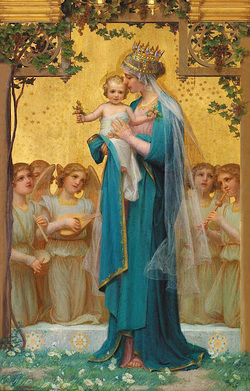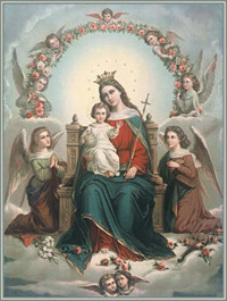
We'll begin by speaking about the sweet Queen of May. As I told you so often, devotion to Our Lady is a sign of predestination. Therefore, of Mary we can never say enough—and certainly never too much. Listen! If all the angels and saints in heaven, and all the fair things thereof, were placed on one side, and just the Immaculate Virgin on the other, which side would give more joy to God, which would be more precious and more beautiful in His eyes? Oh, I needn't think one moment! The Mother of God, we know, is holier and more like God, and therefore more pleasing to Him, than all the others put together.
How proud and happy we ought to be, my boys and girls! For this glorious Mother of God is our Mother, too. I was in a large school one day and found a lovely May altar in each and every room. But the very nicest, I thought, was in the eighth-grade room. And there, on the blackboard, written in Sister's artistic hand, I read the words, "Angels may call her Queen, but they cannot call her Mother!" How true that is! When did Mary become our Mother? Who knows that? Why, it was on Good Friday, when Jesus looked down upon His sorrowful Mother at the foot of the cross and said to her and to St. John, who took the place of us all, "Behold thy son," "Behold thy Mother." She is truly our Mother, Mary is. Let us love her dearly and talk to her in prayer just as we chat with our "Mother" at home. May the twelfth is Mother's Day. Well, don't forget that Mary is Mother too!
Who started the beautiful practice of May devotions? Some think it was genial St, Philip Neri, who died about 1595. Others say it was Father Salomia, S.J., who lived in the eighteenth century. At any rate, this Jesuit Father wrote the first "Month of May." Do you know what he says at the beginning of that little book? I want you to remember it well. He says, "The month of May, at the return of spring, is often a danger to innocence. By means of this happy devotion this critical season becomes a month of salvation."
According to Father Tom Burke's story of the institution of the May devotions, they started at the beginning of the nineteenth century. And we little ones should be proud of the fact that children began it. One day, you see, a little boy stopped before a statue of the Virgin and Child in one of the streets of Rome. Looking up at the statue, he lisped Our Lady's litany; and be liked it so well there that he came again. Pretty soon he began to sing the litany. Other children heard him and came to sing along. So after some time there was a large gathering of little ones round the Virgin's statue. Then pious mothers, some of whom had doubtless come to see what their little ones were up to, joined the throng. Well, the long and the short of it was that a priest saw the devout group. He invited them into church, decorated and lighted up the Virgin's altar, and gave a little Marian talk. Then they said some prayers, sang some more songs, and went home. What had happened? The first May devotions, of course!
Pope Pius VII , March 21, 1815, granted three hundred days' indulgence for each day to the faithful who during the month of May, daily practice some devotion, or say some prayers, public or private, in honor of Mary. So remember the rosary, my boys and girls, and the litany, and the Memorare, and the three Hail Mary's, and all the other beautiful ways to making happy the heart of our heavenly Mother.
Source: "Talks to Boys and Girls," Imprimatur 1930
A coloring picture of Our Lady can be found below:
How proud and happy we ought to be, my boys and girls! For this glorious Mother of God is our Mother, too. I was in a large school one day and found a lovely May altar in each and every room. But the very nicest, I thought, was in the eighth-grade room. And there, on the blackboard, written in Sister's artistic hand, I read the words, "Angels may call her Queen, but they cannot call her Mother!" How true that is! When did Mary become our Mother? Who knows that? Why, it was on Good Friday, when Jesus looked down upon His sorrowful Mother at the foot of the cross and said to her and to St. John, who took the place of us all, "Behold thy son," "Behold thy Mother." She is truly our Mother, Mary is. Let us love her dearly and talk to her in prayer just as we chat with our "Mother" at home. May the twelfth is Mother's Day. Well, don't forget that Mary is Mother too!
Who started the beautiful practice of May devotions? Some think it was genial St, Philip Neri, who died about 1595. Others say it was Father Salomia, S.J., who lived in the eighteenth century. At any rate, this Jesuit Father wrote the first "Month of May." Do you know what he says at the beginning of that little book? I want you to remember it well. He says, "The month of May, at the return of spring, is often a danger to innocence. By means of this happy devotion this critical season becomes a month of salvation."
According to Father Tom Burke's story of the institution of the May devotions, they started at the beginning of the nineteenth century. And we little ones should be proud of the fact that children began it. One day, you see, a little boy stopped before a statue of the Virgin and Child in one of the streets of Rome. Looking up at the statue, he lisped Our Lady's litany; and be liked it so well there that he came again. Pretty soon he began to sing the litany. Other children heard him and came to sing along. So after some time there was a large gathering of little ones round the Virgin's statue. Then pious mothers, some of whom had doubtless come to see what their little ones were up to, joined the throng. Well, the long and the short of it was that a priest saw the devout group. He invited them into church, decorated and lighted up the Virgin's altar, and gave a little Marian talk. Then they said some prayers, sang some more songs, and went home. What had happened? The first May devotions, of course!
Pope Pius VII , March 21, 1815, granted three hundred days' indulgence for each day to the faithful who during the month of May, daily practice some devotion, or say some prayers, public or private, in honor of Mary. So remember the rosary, my boys and girls, and the litany, and the Memorare, and the three Hail Mary's, and all the other beautiful ways to making happy the heart of our heavenly Mother.
Source: "Talks to Boys and Girls," Imprimatur 1930
A coloring picture of Our Lady can be found below:
| may_4th.pdf |

 RSS Feed
RSS Feed